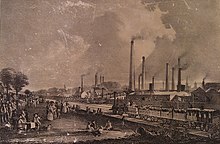
Chlorine is a chemical element; it has symbol Cl and atomic number 17. The second-lightest of the halogens, it appears between fluorine and bromine in the periodic table and its properties are mostly intermediate between them. Chlorine is a yellow-green gas at room temperature. It is an extremely reactive element and a strong oxidising agent: among the elements, it has the highest electron affinity and the third-highest electronegativity on the revised Pauling scale, behind only oxygen and fluorine.

The chemical industry comprises the companies and other organizations that develop and produce industrial, specialty and other chemicals. Central to the modern world economy, it converts raw materials into commodity chemicals for industrial and consumer products. It includes industries for petrochemicals such as polymers for plastics and synthetic fibers; inorganic chemicals such as acids and alkalis; agricultural chemicals such as fertilizers, pesticides and herbicides; and other categories such as industrial gases, speciality chemicals and pharmaceuticals.

Sodium hypochlorite is an alkaline inorganic chemical compound with the formula NaOCl. It is commonly known in a dilute aqueous solution as bleach or chlorine bleach. It is the sodium salt of hypochlorous acid, consisting of sodium cations and hypochlorite anions.
The Leblanc process was an early industrial process for making soda ash used throughout the 19th century, named after its inventor, Nicolas Leblanc. It involved two stages: making sodium sulfate from sodium chloride, followed by reacting the sodium sulfate with coal and calcium carbonate to make sodium carbonate. The process gradually became obsolete after the development of the Solvay process.

James Muspratt was a British chemical manufacturer who was the first to make alkali by the Leblanc process on a large scale in the United Kingdom.
Calcium hypochlorite is an inorganic compound with chemical formula Ca(ClO)2, also written as Ca(OCl)2. It is a white solid, although commercial samples appear yellow. It strongly smells of chlorine, owing to its slow decomposition in moist air. This compound is relatively stable as a solid and solution and has greater available chlorine than sodium hypochlorite. "Pure" samples have 99.2% active chlorine. Given common industrial purity, an active chlorine content of 65-70% is typical. It is the main active ingredient of commercial products called bleaching powder, used for water treatment and as a bleaching agent.

Olin Corporation is an American manufacturer of ammunition, chlorine, and sodium hydroxide. The company traces its roots to two companies, both founded in 1892: Franklin W. Olin's Equitable Powder Company and the Mathieson Alkali Works. Accidents at Olin chemical plants have exposed employees and nearby residents to health hazards.

Charles Tennant was a Scottish chemist and industrialist. He discovered bleaching powder and founded an industrial dynasty.

Sir Charles Clow Tennant, 1st Baronet, was a Scottish businessman, industrialist and Liberal politician.
United Alkali Company Limited was a British chemical company formed in 1890, employing the Leblanc process to produce soda ash for the glass, textile, soap, and paper industries. It became one of the top four British chemical companies merged in 1926 with Brunner Mond, Nobel Explosives and British Dyestuffs Corporation to form Imperial Chemical Industries.
Gossage is a family name of soapmakers and alkali manufacturers. Their company eventually became part of the Unilever group. During World War II, all soap brands were abolished by British government decree in 1942, in favour of a generic soap. When conditions returned to normal post war, the Gossage brand was not revived by Unilever though the company name is still registered for legal purposes. The online 'Times Index' shows meetings of the Gossage company board until the early 1960s.

William Gossage was a chemical manufacturer who established a soap making business in Widnes, Lancashire, England.

Bleach is the generic name for any chemical product that is used industrially or domestically to remove colour (whitening) from fabric or fiber or to disinfect after cleaning. It often refers specifically to a dilute solution of sodium hypochlorite, also called "liquid bleach".

Charles Wigg was an English manufacturer of chemicals in Runcorn, Cheshire, England. After working as an export agent in Liverpool he joined with two managers of a Runcorn chemical factory to build what was initially known as the Old Quay Chemical Works, and later became Wigg Works. At first the works manufactured soap and alkali, but soon moved to extracting copper from pyrites ash, and later making bleaching powder and ferric oxide. During the later part of the 19th century it was one of the most successful businesses in Runcorn. Charles Wigg retired from the business shortly after it was taken over by the United Alkali Company and died eight years later. The site of the factory has been developed into a nature reserve called Wigg Island.

Chlorine-releasing compounds, also known as chlorine base compounds, is jargon to describe certain chlorine-containing substances that are used as disinfectants and bleaches. They include the following chemicals: sodium hypochlorite, chloramine, halazone, and sodium dichloroisocyanurate. They are widely used to disinfect water and medical equipment, and surface areas as well as bleaching materials such as cloth. The presence of organic matter can make them less effective as disinfectants. They come as a liquid solution, or as a powder that is mixed with water before use.

Liquid bleach, often called just bleach, is a common chemical household product that consists of a dilute solution of sodium hypochlorite and other secondary ingredients. It is a chlorine releasing bleaching agent widely used to whiten clothes and remove stains, as a disinfectant to kill germs, and for several other uses.
C. Tennant, Sons & Company was a British merchant bank that was prominent in metals and minerals markets, and also played a key role in development of the Gulf States in their early years of independence. The firm's antecedents go back to the early 19th century. In the early 1960s it had its main offices at Harp Lane in the City of London as well as offices in New York, San Francisco, São Paulo, Lima, La Paz and Bermuda.
The Bonnington Chemical Works was a pioneer coal tar processing plant established in Edinburgh. It was probably the first successful independent facility established for the integrated treatment of gasworks waste, and manufactured the residues of the Edinburgh gasworks into useful products for over half a century.
James MacTear was a Scottish chemical engineer who became a partner and the technical manager of the St Rollox Chemical Works in Glasgow. Mactear was known for inventing a rotating furnace that was used for the continuous manufacturing of sodium sulfate. He influenced the technical development of the chamber process for making sulphuric acid. In 1871, MacTear, created a chemical process to recover sulphur from the alkali waste piles behind the factory at St Rollox. In 1879, MacTear was the first to discover the process to make artificial diamonds. In 1884, MacTear left Glasgow for London becoming a specialist in the metals and metallurgy of mercury and gold.
















